Table of Contents
Bleeding Heart Tetras
Bleeding heart tetras are highly agile and like swimming as they are mostly freshwater fish. The optimum home for them would be a medium-sized tank with plenty of swimming room. You should keep at least four to six fish in a single group. The fish will collectively group up, swim around the tank, and depend on one another to regulate tendencies.
Bleeding Heart Tetra Overview
The Bleeding Heart Tetra, also known as Punto Rojo or Red Tipped Tetra, is a very easy to keep tropical fish, as it is very hardy, so it is one of the most suitable fish species for beginner aquarists.
| Information Chart | Bleeding Heart Tetra |
|---|---|
| Family: | Characidae |
| Scientific Name: | Hyphessobrycon erythrostigma |
| Care Level: | Easy to Moderate |
| Temperament: | Peaceful |
| Color: | Beige-Orange to silvery-lavender |
| Lifespan: | 3-5 years |
| Size: | 3 inches |
| Diet: | Omnivore |
| Minimum Tank Size: | 20 gallons |
| Temperature: | 72°- 80°F |
| Water Conditions: | Soft, Acid Water |
| Tank Mate Compatibility | Compatible |
Having said that, they’re extremely popular among experienced aquarists. One of the primary reasons behind that is their body’s bold and attractive spots. This feature makes it a unique species among the other popular freshwater fishes.
Bleeding Heart Tetra Appearance
They distinguish themselves by the red spot on their sides, generally beside the gills, commonly known as a “heart,” which gives the species its popular name, “bleeding heart,” tetra. Don’t worry; that’s not where its heart truly resides!
Being schooling fish, they are very active and will surely turn out to be your aquarium’s main attraction.
Bleeding Heart Tetra has a diamond-shaped body, common to most freshwater tetras. Its body is compressed laterally on the two sides, with a tall center bone. Its read and black-hued eyes accompany a pointed snout that comes tapering down from its head.
Although the red spots are a distinguishing feature of bleeding hearts, they also have beautiful rosy silver scales. This color can become even more pronounced with a proper diet and if the fish are kept in favorable living conditions.
Similar to their brethren bleeding hearts also have a long anal fin. This fin typically starts from the midpoint and continues till its tail. Another interesting feature of bleeding hearts is its transparent tailfin, pectoral fin, and anal fin. It complements the red and black splashes on its dorsal fins well and helps them stand out.
Lifespan Of Bleeding Heart Tetra
The Bleeding Heart Tetra’s usual life span is between 3-5 years and reaches up to 3 inches in length. Females are usually more full-bodied, and males have a larger dorsal fin.
However, the lifespan and length of these fish depend on several factors. If you’re looking to have a happy and healthy Bleeding Heart Tetra in your aquarium, give them good care.
That involves ensuring its water needs, good diet, oxygen levels, and a whole host of other factors. If your fish feels stressed, it can easily lead to diseases and even premature death.
Bleeding Heart Tetra Size
The freshwater fish typically grow up to 64mm. In other words, it can grow between 3 inches on the lower end up to 6 inches for the larger specimens.
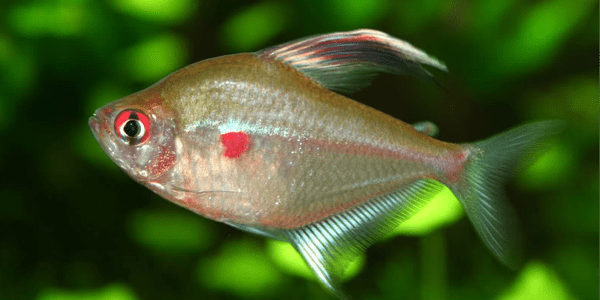
Bleeding Heart Tetra Natural Habitat And Origin
The Amazon River Basin and other South America and Columbia river basins are its original habitat. Still, they are very easily bred in aquariums as well.
The fish species prefer living in slow-moving water, ideally, in distributaries of main rivers or forest lakes.
Bleeding hearts can thrive very easily in water shaded by the thick canopy of the forest, hence the choice. These species of tetras are mid-dwellers and don’t like going deep in the water. Instead, you’re more likely to find them in shallow waters with overhanging vegetation.
Bleeding Heart Tetra Care & Tank Set-Up
Bleeding Heart Tetra Tank Size And Specifications
Having an aquarium setup tailored to bleeding hearts is the best way to take care of these fish. That’s why starting with stable and clean water allows your fish to thrive.
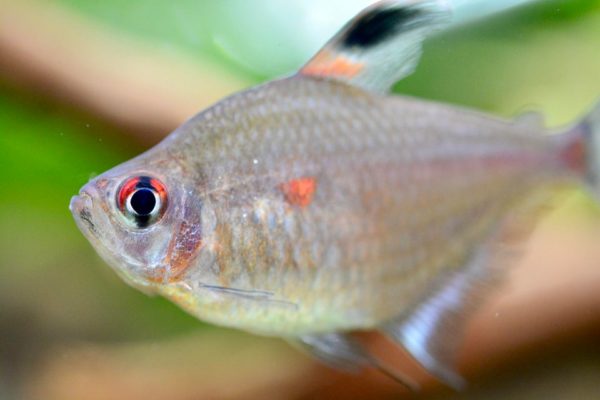
The tetras are primarily freshwater fish and hence are quite agile and love to swim around. A medium-capacity tank with ample space for swimming would present them with the ideal environment for habitat.
Optimum Tank Size For Bleeding Heart Tetra
The minimum tank for a small school of Bleeding Heart Tetras (4-6 fish) is about 20 gallons. You can always go beyond that mark. However, to provide the best environment for your tetras, try to limit the tank size below 55 gallons.
Filtration
They will usually swim through the bottom to middle areas of the aquarium, so if you see your fish swimming towards the surface, this means they do not have enough oxygen and you should take care of that matter immediately.
Try and solve the problem by installing a high-quality water filtration device in the tank. That would help keep the water clean and maintain a fresh environment.
However, when selecting a new system, research the kind of filtration the device offers. Typically it can be anyone between biological, chemical, or mechanical. Although more sophisticated systems can combine two or all of these filtration types.
A strong filtration device can help cycle the water multiple times each hour. Bleeding tetras are known for producing a lot of waste. That’s where a powerful filtration system comes in handy. It can help maintain a low ammonia and nitrate level in the tank.
There’s also no need to bother about adding water bubbles. Bleeding hearts prefer living in slow-flowing water; hence bubbles won’t be welcomed by the species.
Lastly, when setting up your tank, don’t forget to include a gravel siphon. Replacing 20% of your water partially every few weeks is a good habit. During those changes, you would ideally want to use a gravel siphon as well. While filtration devices are immensely useful in a tank, large materials like dead fish or rotting leaves can prove to be impossible for them to remove.
Luckily, that isn’t the case for gravel siphon. It can efficiently remove large waste particles from your tank without causing you much headache. The powerful vacuum of the device also works great to remove debris from the substrate, plants, and ornamental decor within the aquarium.
Substrate
Bleeding hearts are found most commonly in South American waters. So try to use a substrate that can best imitate the surroundings of its natural habitat. So try picking a dark substrate for your fish. It would provide them with a more peaceful environment and comfort in the new surroundings.
You also need to consider that these fish are mid-dwellers. That means they prefer diving to the aquarium floor to scavenge food. This scavenger instinct of bleeding tetra makes it important to choose a soft substrate to line the tank’s floor.
Water Parameters For Bleeding Heart Tetra
Water should be kept around 72-80° Fahrenheit, and pH should be slightly alkaline, between 6.5-7.0. These fish prefer mildly acidic, peat-filtered water. Bleeding hearts are also best suited to soft water with a hardness range between 3-12 dGH. Mimicking these conditions can be your best bet to have a healthy shoal of fish in your tank.
Bleeding Heart Tetra Tank Landscape
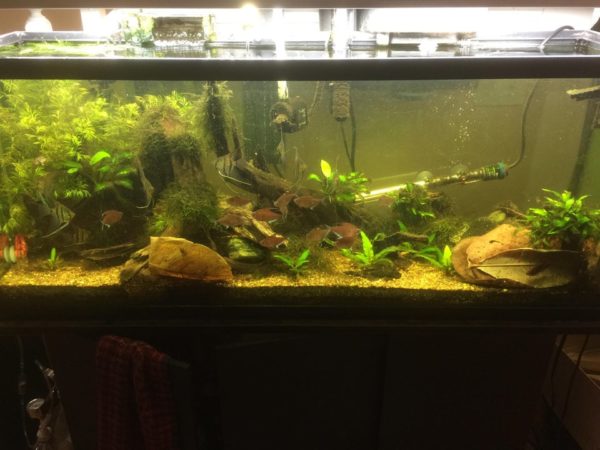
Best Plants For Bleeding Heart Tetra Tanks
These fish have minimal requirements for vegetation and give you lots of room to play around. Ideally, your fish would prefer plants like Guatteria scandens or Strychnos blackii. However, these plants are native to the Amazon Basin and aren’t suited for home aquariums.
Hence try decorating your tank with plants like- Cryptocoryne beckettii, Aponogeton ulvaceus bulb, Dwarf aquarium lily, Amazon sword, or Java fern. Natural driftwood is yet another great substrate choice. It can give your fish some security and provide an organic look to your tank.
Decorations For Bleeding Heart Tetra Tanks
These tetras are also a fan of dry leaves. Sprinkle some on the floor of your aquarium. Dry leaves also add an extra dimension to the lighting of your tanks and make them a better environment for your fish by promoting microbial growth.
However, going down this route means replacing the leaves twice a month. They decay quite fast, and if left out for long, they make the water murky and deteriorate its quality.
Lighting For Bleeding Heart Tetra Tanks
While deciding the substrate, also pay keen attention to the lighting of your tank. Move away from adding bright lighting. Instead, normal or moderate lighting will be preferable to your fish. Dim light helps in brightening and saturating the color of bleeding hearts. It can help provide an attractive look to your aquarium.
Bleeding Heart Tetras only display their best colors when feeling secure, so make sure water parameters stay the same. Also, provide a lot of plants and hiding places, subtle lighting and dark gravel to make them feel more at ease.
Feeding your Bleeding Heart Tetra
Bleeding hearts are omnivores. That means food for this fish species is pretty easy to find, as they accept any food usually given to tropical fish: live food, flakes, freeze-dried, or frozen food. If you plan to give them flakes or crisps as their main diet, try to offer them extra protein occasionally by giving them frozen or live foods.
In the wild, these tetras have an extensive taste palette. They can easily sustain aquatic insects or larvae and aquatic plants. However, when at home, it’s better to promote a varied diet for your fish to provide them with better nourishment. As you can already see, they are more than happy to accept natural and commercial food products.
You can also increase the nutritional content of your fish’s diet by offering them frozen or live blood worms. They are also more than happy to feed on brine shrimps or any sort of live fish foods. However, like any other pet, be wary of overfeeding your fish.
How Often Should You Feed Bleeding Heart Tetra?
Also, as they are opportunistic feeders and usually eat vegetable material in the wild, you could give them chopped lettuce leaves as an occasional treat. They should be fed several times during a day, but never give them more than they can eat in 3 minutes.
Try and keep the feedings small to avoid overfeeding your fish. Large feedings also have the undesirable side effect of depositing at the tank’s floor. That’s harmful to the water quality of your tank as it can alter the pH of the water.
Bleeding Heart Tetra Behavior and Temperament
Is Bleeding Heart Tetra Lone Or Societal In Nature?
The Bleeding Heart Tetra is a schooling fish, which means it is necessary to keep 4-6 fish to make them feel at ease and secure in your aquarium. These tetras prefer to meet and navigate together with other species members. Besides, the colorful collage also makes for great viewing.
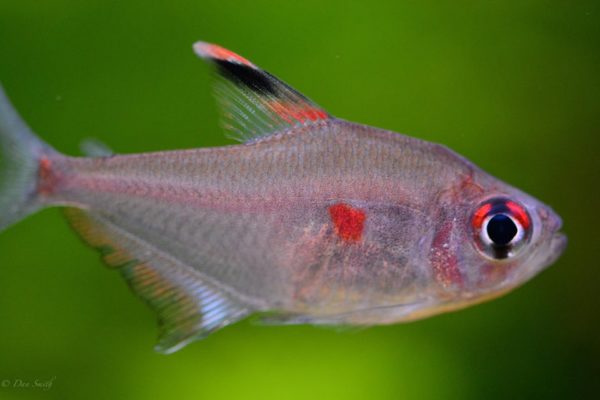
Tetras are also active swimmers, especially when they have company. If left with a large shoal, you can find them zipping in and out of the decor and exploring the surroundings. For this reason, bleeding heart tetras are an excellent pick for community tanks as well.
Bleeding hearts prefer a communal life. It can quickly acclimatize to its surroundings and engage in social activities with its neighbors. If kept alone, it can be prone to fin nipping because of stress and it is also very likely to die or behave aggressively towards their surroundings or neighboring fish and try to scare them. Bleeding hearts can also behave in this hostile fashion if they are hungry or feel anxious for some reason.
They can also easily become extremely shy when alone and spend most of their time behind natural covers, away from public eyes. Most of the time, they’re incredibly calm. Though they are shy fish, though, but very peaceful once they settle in your aquarium, especially if they are kept in a larger school.
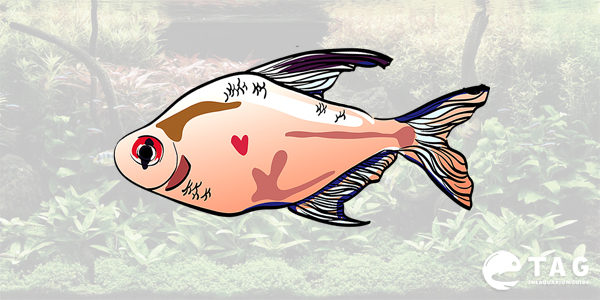
Bleeding Heart Tetra Tank Mates
First of all, make sure you keep an established school of tetras, as their best behavior and distinctive color patterns can only be seen in small to large groups.
Other tetra varieties could be the best tank mates for your Bleeding Hearts and would also help them stand out, as most of the tetras have slim bodies, unlike the Bleeding Heart Tetra, which has a larger, flatter body.
Also, you can choose tetras of different colors to add variety to your aquarium.
Unlike many other fish species, tetras feel extremely comfortable living with a wide range of tank mates. Smaller or same-sized fish would make great companions for your tetras, as they will not be intimidated or harassed by them. Danios, cherry barbs, Rasboros, and some bottom dwellers such as some loaches or cories are usually peaceful fish that could live happily alongside Bleeding Heart tetras.
Try to avoid placing less active species, like dwarf cichlids, as a tetras fast movements can cause them a lot of stress. Considering how radically different they are in temperament and behavior, that’s understandable.
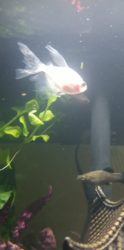
Also, larger fish, especially cichlids that are particularly aggressive and territorial, could find your tetras to be a tasty meal and chase them around.
Ideal Bleeding Heart Tetra Tank Mates
Some of the popular fishes you can use as tank mates for your bleeding hearts are:
- Black Tetra- They can be a great mate for your fish. The darker scales of the species can complement the colorful vibrance of bleeding hearts quite well. Black Tetras are extremely peaceful and rarely behave aggressively with their neighbors
- Rasbora- The striking color of the Rasboras and their iconic markings makes them a popular choice for aquariums. More importantly, Rasboras are extremely peaceful and ideal as tank mates.
- Odessa Barb- Like tetras, Odessa barb is also a freshwater fish. They are extremely popular among fish enthusiasts for their quiet demeanor and tenacious attitude. Hence, there’s no reason for you not to pick them as tank mates for your bleeding hearts.
- Kuhli Loach- Kuhli Loaches are the ideal aquarium fish. They play along extremely well with their neighbors but are known best as cleaner fish. They help control the water quality of your tank, while their stunning appearance also makes for a great show.
Bad Tank Mates For Bleeding Heart Tetra
While Bleeding Hearts can go very well with most fishes, that’s not the case for every one of them. That includes:
- Angelfish- Angelfish are infamous for lashing out aggressively towards their tank mates. Male Angelfish are the worst offenders, and you can do well by avoiding them.
- Fancy Goldfish- Fancies are peaceful species. However, they are not ideal mates for your bleeding hearts. They are extremely slow swimmers and might get bullied by the fast swimming tetras.
- Bala Shark- Bala Shark can be a bit shy and prefers to stay hidden in roots. Even though not aggressive, Bala sharks are notorious for chasing and eating smaller fishes like tetras.
- Clown Loaches- Clown Loaches, although typically peaceful, often jostle with their tank mates for the position. You don’t want your peace-loving bleeding hearts to live with them.
- Texas Cichlids- When it comes to tank mates, Texas Cichlids are the worst to choose for tetras. They are an extremely aggressive species and are better to leave out the conversation.
Breeding Bleeding Heart Tetra
Bleeding Heart Tetras may be bred in the community tank, but it is always best to do this in a breeding tank, as special water parameters are required for successful breeding.
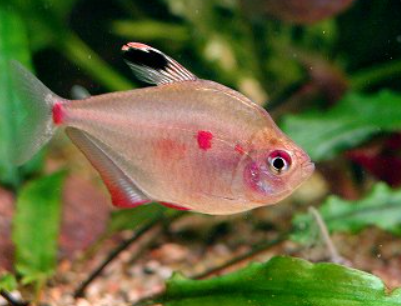
Water should be slightly acidic to encourage optimal breeding habits. Also, to speed up the process, you should increase the temperature by a few degrees, but make sure it is still comfortable for your other fish.
After the eggs are laid, the parents should be removed from the tank to avoid the fry being eaten.
If you cannot afford a breeding tank, you can still breed them in the community tank, but make sure you provide plenty of plants for the fry to hide from the bigger fish.
Bleeding Hearts Tetras Breeding Level
Easy
Bleeding Hearts Tetras Sexual Dimorphism?
Distinguishing between male and female bleeding hearts isn’t very difficult. The females of the species are easily distinguishable from the males of the species from their fuller bodies.
In comparison, the males have a much larger dorsal fin, along with a longer and much more entended anal fin. In males, the elongated dorsal fins acquire the shape of a sickle that arches till the tail base. On the other hand, the dorsal fins in females appear much more rounded in shape.
Bleeding Hearts Tetras Common Diseases and their Treatment
These fish can catch any tropical fish disease; keep an eye on their immunity and water conditions. A dirty tank could affect even the most enduring fish. For this reason, keeping fresh and clean water in your tank should be the first of your priorities. If you’re able to ensure that, there’s very little reason to be worried about the health of your fish.
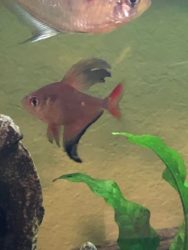
Despite being raised in fish farms nowadays, your Bleeding Heart Tetra can still be kept in various community tanks before reaching you, so make sure you quarantine every new fish to be able to spot any signs of illness and treat the affected fish only.
Typically, foamy or cloudy water is the first indicator of polluted water. A prime reason behind this occurrence can be an invasion of microorganisms in your tank. To avoid any such occurrence and promote better health of your tank, look to change your water frequently. Try replacing 20% partial water every other week by the rule of thumb.
Your fish can sometimes also suffer from common ailments like ich or fin rot. Similarly, fungal infection is a common disease that most fish owners have to deal with. Be on the watch out for any change in the typical behavior of your fish. That can be something as innocuous as tiredness or lethargy.
You’re likely to find plenty of medications to combat these diseases. However, the simple solution lies in taking prevention to avoid fungal growth in your tank instead of having to tackle it later on.
Facts About Bleeding Hearts Tetras
- The species mainly feeds on living and frozen foods and micro pellet food.
- Their average litter size is 60-130 eggs
- The fish can grow up to 3 inches or 8 cm
- Bleeding hearts have wet and slimy scales
- The fish can be found extensively in South America, Columbia, and Upper Amazon Basin
FAQ
Do They Prefer Living With Other Tetras?
Bleeding Tetras prefer living among their kind. A major reason for this behavior is the schooling nature of the fish. It’s also easier to maintain them as they have similar requirements.
Can I Keep Betta With Bleeding Heart Tetras?
Bleeding heart tetras are compatible with many fish species, including bettas. However, if suffocated, bleeding tetras lash out by opening their nippers. That can harm your bettas, and why you should be cautious when pairing them.
Where To Buy Bleeding Heart Tetras?
Bleeding hearts are extremely easy to purchase. You can find them in almost any pet store or hobbyist store. They are also popular in most online fish stores and are extremely moderately priced.
Can Bleeding Heart Tetras Live For Seven Years?
Bleeding heart tetras are an extremely resilient species. When in an aquarium or a fish tank, they need perfectly habitable surroundings to sustain themselves longer. The average life span of a bleeding heart can stretch to 3-5 years under proper facilities.
Conclusion
Bleeding Heart Tetras are interesting fish to keep for their beautiful colors and active behavior. The fish has minimal requirements and is easy to care for. That makes them the perfect fish to care for, especially for a beginner.
However, the fish can be quite fickle in its water requirements. Bleeding hearts need a stable, fresh, and clean water source to live healthily. They are also an extremely compatible fish species and can stay with a wide range of mates.
By paying a bit more attention, even beginner aquarists may successfully keep these interesting fish, even though they are not as hardy as other fish, like guppies or Mollies. With all that said, it’s still a beautiful fish and very easy to care for. Try to keep them in a comfortable and stress-free environment, and you will reap the rewards.
No related posts.

1 thought on “Bleeding Heart Tetra: Care Guide, Breeding, & Tank Size”
i have six bleeding heart tetras in my planted 180l tank they’re very well behaved and mix well with my diamond tetras and my cardinal tetras. they all go mad for live food including daphnia bloodworm and brine shrimp.One point however the bleeding hearts are a bit sensitive to co2 if i turn it up too much they start breathing faster.